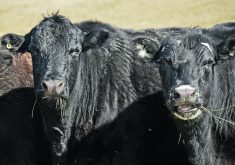From the omnipresent wafting of rich wood smoke, the scent of slow-cooked meat roasting inside smokers and the sight of succulent pork on skewers, in slabs and slices and shredded, you know you are never more than a few steps from a culinary delight at the World Pork Expo in Des Moines, Iowa.
But inside an air-conditioned meeting room a few metres from the steamy smoked pork surrounding the Varied Industries Building, a panel of consumer market experts is being confronted by an exasperated U.S. Department of Agriculture official and avowed pork fan.
Read Also

Prairies have variable soil moisture conditions
The dry weather in the west was welcome for preserving grain quality and advancing harvest, but it has resulted in very dry soil moisture conditions.
Related stories in this issue:
- VIDEO: Hog price outlook grim as California’s Proposition 12 looms
- Pig producers look to future despite challenges
“Throw some fat back in there,” she admonishes, upset by decades of prime pork suffering from decades of industry efforts to squeeze the fat out of pig meat, ending up with an animal protein that can be dry, chewy and tasteless.
What provokes her outrage as she daily views the USDA’s cut-out value reporting is the reality that pork loin, the highest quality part of the carcass, is a discounted product. It’s cheap. It’s sold as cut-price protein.
“It’s a loss leader,” acknowledges David Newman, an Arkansas State University professor and soon-to-be U.S. National Pork Board official, who is delighted by the challenge.
It’s something that has outraged him as well for decades. Pork loin, from which pork chops — the steak of pigs — come, is cheap. Really cheap. Awesomely cheap.
I, as the father of three growing children and husband of a barbecue-loving wife, can attest to this. When I look for something meaty to throw on the grill to delight my family, I’ve backed off beef. Steak is really, really expensive these days.
Pork is not.
I can buy a bunch of thick, rich pork chops cheap and produce a happy reaction from the fam.
But I admit to a lot of fear when I cook regular chops. Will I overcook them? Will they be dry and draw sour looks from my wife and kids? Will I mess them up?
So I generally stick with local Berkshire pork chops for grilling, which are well-marbled and allow me to not fail.
But that isn’t something I should have to worry about, which is the point of the frustrated pork fans in Des Moines.
Cooking pork shouldn’t instil fear, but it does for many people. According to panellist Kiersten Hafer, domestic market development vice-president at the National Pork Board, about half of first-time chop buyers buy chops again. By the third or fourth time, it’s hard to convince even one-quarter to keep buying commodity pork chops.
“Something happens,” she notes.
That something is likely the problem with dryness and tastelessness that came out of decades of anti-animal-fat sentiment that dominated our culture since the 1980s and has only recently abated. The hog industry was told to cut out the fat, to become “the other white meat,” and it did.
All too successfully.
It’s trying to turn the ship around now, with consumers voting against pork, science saying animal fat might not be so bad after all and returns for always-cheap pork not making many in the hog industry happy.
The good news, according to Newman, is that there has been much improvement in the last five years, with genetics companies and production specialists bringing culinary quality back into the equation. The bad news, according to everyone on the panel, is that it will take many years to get pork back to where consumer tastebuds probably think it should be. It took a long time to get where it got, and it’ll take a long time to get away from there.
Glynn Tonsor, a Kansas State University agricultural economist, said farmers and the industry should be careful when assuming the future is necessarily more fat-friendly and less concerned about health impacts. Health scientists could discover something tomorrow that sends things back the other way, so people need to stay flexible when dealing with shifting currents in consumer and social tastes.
But Hafer highlighted another often-ignored issue: people under the age of 40 don’t know how to cook a pork chop, or anything requiring a lot of cooking skill.
Rather than bemoaning the lack of demand for prime pork cuts that aren’t low priced, perhaps the industry needs to help teach people how to cook and produce great-tasting food.
Obviously, pork can be cooked well and taste great. The mountains of pork cooked and served at the World Pork Expo attest to that.
But to turn the consumer from being a buyer who sees pork as cheap and back into one who sees it as yummy and worth paying more for must be the target.
Discounting pork loins is a disgrace. It’s time for pork to regain its honour.
















